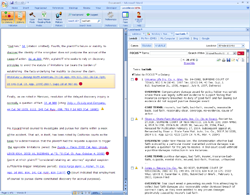Lexis Turns Up Heat on Legal Research Competition Today: Unveils Partnership with Microsoft
The competition for your legal research dollars just got a little more intense today as LexisNexis unveiled at LegalTech in New York its newest offering: a partnership with Microsoft.
Lexis will now be integrated into Microsoft Office products, allowing users to do legal and general research directly while working in Microsoft Word, Outlook and SharePoint. Users, who must have a Lexis subscription, need only click on a Lexis tab in the ribbon of utilities available in Microsoft Office 2007 and the forthcoming 2010 version to start researching, Shepardizing cases or even gathering information from Bing or Google search engines. There is no need to navigate separately to the Web and log on to Lexis or a search engine.
“If you think about where our customers spend their time, it’s either in e-mails or in Word creating or reviewing documents,” says Clemens Ceipek, vice president of New Lexis. “That is exactly what we are doing. As a lawyer you no longer need to go to a separate, dedicated site to get the information.”
The Lexis-Microsoft partnership is another salvo in the forthcoming legal research product wars. Later this year LexisNexis will introduce a completely revamped Lexis that is easier to use, sorts results more visually and pulls in information (albeit filtered) from the open Web. Thomson Reuters has revamped Westlaw, which also will debut at LegalTech. Westlaw Next also promises more ease of use, better search results and data displayed in a more user-friendly manner. Bloomberg also has revamped its legal research product to make it Web-based, and has bolstered its content significantly.
Lexis began working with Microsoft over a year ago as part of its research and development process on new Lexis. Ciepak says this product represents only the beginning collaboration between the two companies, but declined to disclose what’s in the pipeline.
The new Lexis for Microsoft Office represents a giant step forward for lawyers who are used to navigating between screens when drafting or reviewing documents.
Once the Lexis tab is toggled “on,” users can access a variety of information from Lexis. Because the utility is based on the new Lexis platform, it also incorporates some of that platform’s features, such as results pulled from Lexis’ filtered Web search function. A user reviewing a brief in Word can click on the Shepard’s tab and see the validity of all cases in the document. If the user wants to read the cases, clicking on another tab splits the screen and pulls up all the cases.
Users also can find information about a person or case or related documenting by highlighting text, which brings up information stored in a firm’s document management system, the user’s own computer or, with other clicks, pulled from the Web.
When incorporated into Outlook, Microsoft’s signature e-mail program, the same options are available. The Lexis product also is integrated with Microsoft’s SharePoint, a document management system that allows a group of users to store, share, update and manage documents.
The research and information data accessible via Lexis for Microsoft Office is vast, but is not the complete set of data and information available through Lexis.com, says Darrell Huntsman, vice president for New Lexis Innovation Initiatives.
Huntsman says the company had to impose some limits on the databases because of the different subscriptions that users across the country have. Users will be able to limit the databases they can access through a preferences tab, but Huntsman says the company anticipates users going outside their subscription databases as they more fully explore the software’s capabilities.
For now, Lexis does not plan to charge any additional fees for accessibility through Microsoft Office. However, a company spokesman cautions that the software may require additional set-up costs.




